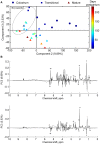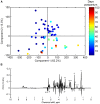The Effect of Gestational and Lactational Age on the Human Milk Metabolome
- PMID: 27213440
- PMCID: PMC4882716
- DOI: 10.3390/nu8050304
The Effect of Gestational and Lactational Age on the Human Milk Metabolome
Abstract
Human milk is the ideal nutrition source for healthy infants during the first six months of life and a detailed characterisation of the composition of milk from mothers that deliver prematurely (<37 weeks gestation), and of how human milk changes during lactation, would benefit our understanding of the nutritional requirements of premature infants. Individual milk samples from mothers delivering prematurely and at term were collected. The human milk metabolome, established by nuclear magnetic resonance (NMR) spectroscopy, was influenced by gestational and lactation age. Metabolite profiling identified that levels of valine, leucine, betaine, and creatinine were increased in colostrum from term mothers compared with mature milk, while those of glutamate, caprylate, and caprate were increased in mature term milk compared with colostrum. Levels of oligosaccharides, citrate, and creatinine were increased in pre-term colostrum, while those of caprylate, caprate, valine, leucine, glutamate, and pantothenate increased with time postpartum. There were differences between pre-term and full-term milk in the levels of carnitine, caprylate, caprate, pantothenate, urea, lactose, oligosaccharides, citrate, phosphocholine, choline, and formate. These findings suggest that the metabolome of pre-term milk changes within 5-7 weeks postpartum to resemble that of term milk, independent of time of gestation at pre-mature delivery.
Keywords: NMR; human milk; infant; metabolites; metabolomics; nutrition; pre-term.
Figures






References
-
- Lawrence R.M. Breastfeeding, Host-resistance factors and immunologic significance of human milk. In: Lawrence R.A., Lawrence R.M., editors. Breastfeeding. A guide for the medical profession. Elsevier; Philadelphia, PA, USA: 2006. pp. 171–214.
-
- Sullivan S., Schanler R.J., Kim J.H., Patel A.L., Trawöger R., Kiechl-Kohlendorfer U., Chan G.M., Blanco C.L., Abrams S., Cotten C.M., et al. An exclusively human milk-based diet is associated with a lower rate of necrotizing enterocolitis than a diet of human milk and bovine milk-based products. J. Pediatr. 2010;156:562–567. doi: 10.1016/j.jpeds.2009.10.040. - DOI - PubMed
MeSH terms
Substances
LinkOut - more resources
Full Text Sources
Other Literature Sources
Medical

